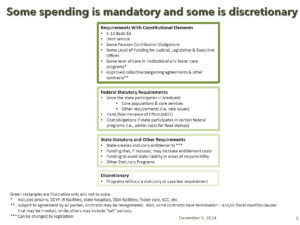Operating Budget
Due to inflation, increased need of state services, federal actions related to funding services and tariffs, and declining growth in our tax revenues, Washington state faced a budget deficit around $16 billion this year. House Democrats took a balanced approach to resolving the deficit. Our goal was simple: Do the least amount of harm in our reducing of expenditures and maintain programs that provide food, shelter, and health.
First, our budget writers scrubbed the budget and identified areas that could be cut. Most of the budget is protected, either constitutionally (such as basic education funding) or through federal contracts and agreements or state laws for programs like Medicaid. That means only around 20 percent of the budget is even eligible for cuts. We demonstrated what those cuts would look like if we did no new tax revenue – see our webpage, wabudgetcuts.com, for more information on an all cuts budget.
After our budget writers identified possible reductions or freezes to program funding, our revenue team came up with options for raising revenue. Through discussions with the governor and Senate counterparts, we identified the revenue that could be raised, primarily on large businesses, technology-related corporations, and an adjustment to the Capital Gains and Estate Tax.
Through this balanced approach, the Legislature adopted a budget that includes $7 billion in reductions to the 25-27 operating budget, and about $8.7 billion in new revenue to the operating budget (spread out over four years). This includes some increases to crucial services and programs, like public schools and housing and homelessness programs.
Here are some of the biggest changes. All numbers are 4-year spending numbers unless specified:
EDUCATION:
- Increases Special Education funding: $775 Million
- Funds increased Local Effort Assistance: $200 Million
- Materials, supplies and operating costs are increased: $215 Million
- Maintains funding for school meals and summer EBT for kids: $45 Million
HOUSING & FOOD:
- Housing & Homelessness Increases: $145 Million
- Youth Homelessness Diversion Funding: $6 Million
- Tenant Right to Counsel Program: $3 Million
- Funds Food Security & Assistance: $128 Million
- Immigrant, Refugee, and New Arrival Supports: $40 Million
PUBLIC SAFETY:
- Community Reinvestment Program: $110 Million
- Local Law Enforcement Grants: $100 Million (one time funding, not ongoing)
- Reentry Center Conversions: $26 Million
- Crime Victims Support: $27 Million
- Public Defense Grants: $13.5 Million
HEALTH CARE, LONG TERM CARE, AND BEHAVIORAL HEALTH:
- 988 hotline & Crisis Facility Grants for three centers: $47M
- Consumer-Directed Employment, Agency Parity & Adult Family Home Agreement: $833 Million
- Nursing home rates and transitions clients to community settings: $55 Million
- Assisted Living Bridge Rates & Community Residential Rates by 2%: $62 Million
- Continues funding for the Apple Health for Immigrants program
- Protects funding for the Cascade Care Savings Program: $84 Million
- Continues the Health Homes Program in 2026: $15 Million
STATE GOVERNMENT, CHILD CARE & HIGHER EDUCATION:
- Collective Bargaining Agreements for State & Higher Ed Employees: $1.7 Billion
- No furloughs for state employees or health care premium changes
- No Tuition increases
- Maximum Washington College Grant awards funded at 60% MFI: $45 Million
- Continues the WSU Native Scholarship Program: $2.2 Million
- Family Child Care Agreement: $376 Million
- ECEAP Rate Increase: $40 Million
- ESIT Multiplier Increase: $36 Million
- JRA Capacity & Security: $51 Million
CLIMATE, CLEAN ENERGY & NATURAL RESOURCES:
- Wildfire Response, Suppression, and Recovery: $22 Million
- Invasive Species Prevention: $11 Million
Learn more at https://fiscal.wa.gov/statebudgets/2025proposals/ho2527bien
Transportation Budget
Like the operating budget, this year’s Transportation Budget began at a deficit. Due to declining revenue from the gas tax due to more fuel-efficient and zero emission vehicles on the road, funding for crucial projects was in jeopardy. Transportation touches every community in Washington state: From ferries and freight to bike lanes and buses. Investing in these crucial systems isn’t an option: it’s mandatory.
House Democrats focused on the problem by delivering a forward-looking transportation budget that delivered on maintenance and preservation projects, and setting the groundwork for a sustainable, safe, and equitable transportation system across Washington state. The Legislature passed a $15.2 billion Transportation Budget that makes those investments in maintenance, as well as safety and mobility, and preserves the state’s commitments for long-term projects, like fish passage barrier removal.
Projects that will continue thanks to this budget include: the Interstate Bridge in Vancouver, the Spokane North-South Freeway, the Gateway Project, and the I-5 Fort Lewis Project.
Final negotiated transportation budget comparison (conference committee report comparison)
House 2025-27 Biennial and 2025 Supplemental Transportation Budget Proposals
Budget Summary (4-page)
Capital Budget
The Capital Budget is often called the construction budget, because it invests in construction projects all across the state, creating jobs and improving communities. The Legislature passed the 2025-27 Capital Budget that invests $7.6 billion in construction projects and infrastructure. Funding goes directly into communities, creating local jobs and stimulating economic growth, while upholding House Democratic values of opportunity for all, protecting the environment, taking care of our neighbors, investing in every corner of the state, and building a better future for our children.

